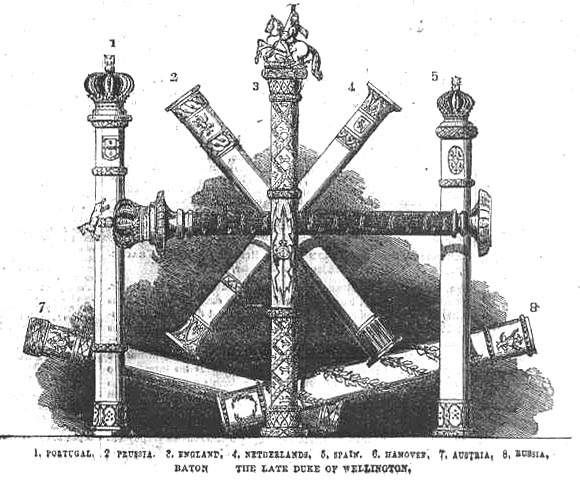
Batons [of] the Late Duke of Wellington. [Scanned image and text by Philip V. Allingham. You may use this image without prior permission for any scholarly or educational purpose as long as you (1) credit the photographer and (2) link your document to this URL in a web document or cite the Victorian Web in a print one.]
In our Engraving, we represent [opposite] the various batons given to the late Duke of Wellington by the Allied Sovereigns, and which were carried by officers deputed from the different kingdoms at his funeral. For more easy reference, we have numbered the batons in the Engraving, andtheir descriptions we now proceed to give. —
No. 1, the Baton of Portugal, is of burnished gold; it is surmounted by a Crown, and on a shield are the arms of Portugal.
No. 2, the Baton of Prussia, is of burnished gold, and is of classic ornamentation; it bears two eagles displayed, holding the sceptre and orb of sovereignty.
No. 3, England, is of gold, and is surmounted with the group of St. George and the Dragon. This baton is excessively rich in its decoration, as our Engraving shows; and at the end of it is engraven this inscription:--
From his Royal Highness
George Augustus Frederick,
Regent
of the United Kingdom of
Great Britain and Ireland
to Arthure, Marquess of Wellesley, K. G.,
Field-Marshall of England.
1813.
No. 4, the Netherlands. This is one of the simplest, but perhaps the most elegant of the batons, the Greek ornaments being introduced very tastefully. The arms of the Netherlands are in the upper division.
No. 5 is the baton of Spain. . Like that of Portugal, it is crowned; but it is shorter in its proportions. It is of burnished gold, and bears the armorial ensigns of Spain.
No. 6 (lying across in our Engraving) is Hanover. The crown and ends of the staff are gold; but the chief part of the baton is covered with crimson velvet, powdered with silver horses--the Hanoverian arms; and a silver horse is placed above the crown.
No. 7 is Austria. This baton is of burnished gold, and the wreaths round it are in dead gold. The other portions are extremely plain; whilst
No. 8, the baton of Russia, is of gold, and the alternate wreaths of laurel and oak, which twine round it; and the colklars round the staff are set with diamonds of great value. The ground is frosted gold.
Related Material
- Articles and images from The Illustrated London News on the Duke of Wellington's Funeral
- A Brief Biography of Arthur, Duke of Wellington
References
"Baton [of] the Late Duke of Wellington." The Illustrated London News. (11 December 1852): 532.
Last modified 9 October 2006